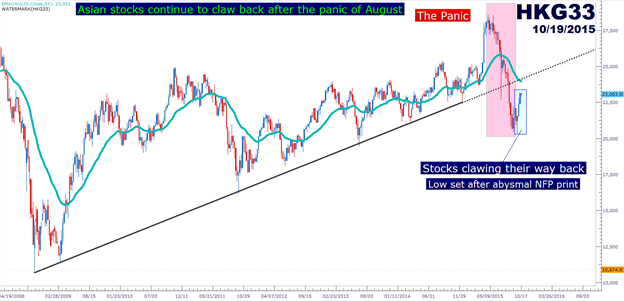Summary:
- Chinese GDP printed below 7% for the first time since 2009.
- This raises concerns for a slowdown in Asia, but the expectation for more stimulus from Beijing has served to off-set the near-term weakness that such a print would bring.
- For those looking for macro cues, watch US Oil (WTI), as this could serve as a leading indicator for macro trends moving forward.
Chinese Q3 GDP was released last night and something that many have feared has finally happened: Chinese growth posted below the 7% target that the economy has been holding on to despite the protracted-slowdown being felt throughout Asia. Q3 GDP posted at 6.9% versus an expectation of 6.8%, and while this meager .1% miss might not seem like all that big of a deal, the symbolism of the country failing to meet their own growth targets confirms the fact that global growth is, in fact, slowing down.
Near-term, this slight beat of estimates combined with the continued expectation for further easing from Beijing in the form of additional interest rate cuts and cuts to bank reserve requirements actually serves as a positive for the Chinese economy (and, in-turn, the rest of Asia). While China is slowing down, the ‘landing,’ at least at this point, hasn’t been as ‘hard’ as many have feared, as the country continues to grow through the multiple recessionary pressures being felt throughout their economy.
This is relevant for the rest of the world because China is still the engine of global economic growth. China’s economy has roughly doubled since the Financial Collapse, and even with these lower growth rates this increased demand comes at a time when economies in Europe, the United States and Asia are struggling for satiety. QE programs from around-the-world can help exports for troubled economies, but you still have to have an economy to export goods and services to for these efforts to actually work.
Chinese stocks have found stability since the panic drives in August sent the Shanghai Composite towards the psychological 3,000 level, and this goes hand-in-hand with many global equity indices that have throttled higher since late September/Early October.
On the chart below, we can see how stocks from Hong Kong have been clawing their way back since the abysmal NFP print only two-and-a-half weeks ago. This was the capitulation point in which risk assets began trading higher along with bad/negative data prints, as it has become more apparent that the Federal Reserve would likely not be hiking interest rates in 2015.

Created with Marketscope/Trading Station II; prepared by James Stanley
Watch Oil Prices as a Leading Indicator: One of the main factors that spread Chinese weakness through the rest of the world was the major hit that commodity prices took on the back of weaker Chinese demand. As the rest of the world has become more and more dependant on Chinese growth, this slowdown in Chinese consumption could spell trouble for prices of raw materials. As Chinese demand slows, commodity prices move lower; and as commodity prices move lower, companies in other, related economies take the hit. Glencore is an example of this, as lower commodity prices have squeezed their margins and this has added pressure on creditors whom they owe money to, and may not be able to re-pay should the slide in commodity prices continue.
This slide in oil prices has muddied the geopolitical picture, as we’re now seeing an increased role in the Middle East from commodity producers (Russia), and this could spell uncertainty for near-term oil prices.
Last week, we had another failed attempt to break above the $50 marker. On Monday, USOil barely breached above $50 before selling came in. We saw a lower-high print on Friday and to open the week just below $47.50, and this could provide a risk management level for a short-entry for those looking for trend resumption.

Created with Marketscope/Trading Station II; prepared by James Stanley
--- Written by James Stanley, Analyst for DailyFX.com
To receive James Stanley’s analysis directly via email, please SIGN UP HERE
Contact and follow James on Twitter: @JStanleyFX






